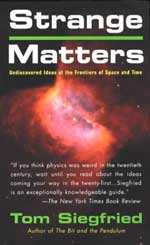
The frontiers of space and time are where the physicists and cosmologist are positioned in their search for an understanding of our surroundings. These theoreticians and experimenters are looking for smaller and smaller particles in our space and at the same time are considering the possibility of more than one universe. For them, time may or may not have begun with the start of the universe. It is a relative dimension, and it may even consist of more than one dimension. As equipment gets more advanced, whether stronger atom smashers or more powerful telescopes, these experts obtain more and more clues about existence and often more and more questions.
In our surroundings stranger and stranger ideas are contemplated. There may be planets without central stars. Our universe may start growing with hyperinflation, slow down growth and then speed up again. Patterns of galaxies look like they grow on bubbles. While great attractors have matter streaming into them. Dark matter and negative energy may be more important than visible matter and known energy in keeping our universe together. The universe could be expanding and continue to do so forever, in steady state, or it could be contracting where a big crunch brings the universe back to that which existed before the big bang. There may be other universes alongside or intertwined with our own, or there may be multiple copies of our universe. Theoreticians are looking at their equations and current observations and trying to make reason of it all. Experimenters, of course, would cherish the idea of travelling about the galaxies so as to equally provide for an understanding. However, for now, being stuck on a planet forces them to make the most of whatever is at hand.
Theoreticians rely, for the most part, on mathematics. Math is a standardized means of expressing relationships between entities. Because of its formality, a mathematical equation will often provide more than just the one answer needed and theoreticians will pronounce new elements or conditions based on these alternate answers. Though these can appear, at first, to be nonsensical, experimenters might then establish proof of the validity of these answers. This method of mathematical ‘prediscovery’ has lead to such exotic concepts as strange matter, dark energy, negative pressure and fractional electric charges. And the theoreticians and experimenters are an essential combination in advancing our understanding.
However, even with the steady advances being made, there still remains their greatest challenge, to combine gravitational force with electromagnetism. Physicists are looking hard for this unifying theory and, though many pronouncements are made, there is still no proof for any particular one. Super symmetry or string theory is a strong candidate. By vibrating at different frequencies or notes, a string could mimic any elementary particle. Recent theories have overcome earlier anomalies in the conservation laws and actually provide tens to hundreds of possibilities. These are now considered to be equivalent candidates as each can fold into the other due to the concept of topology. Experimenters, however, will be challenged as the largest of these strings are believed to be on the order of 10-31 cm. Needless to say they aren’t able to do this, at least yet.
And this is one of the curiosities that Tom raises. Is the universe set in a specific way, for a specific reason, or is it the mathematics that defines the state of the universe? This is termed by the cosmologists as the anthropic principal. That is, people are needed to define that in which they exist so perhaps, without people, this universe wouldn’t exist or at least it wouldn’t the way we know it. Further, mathematics is a human construct. So how is it continually able to predict knowledge? And how is it we can say something exists even though we can’t detect it with any of our five senses? Still, with all the good that has come from curiosity it is fortuitous that people are curious.
Tom’s book is a wonderful tour de force of current thinking in physics and cosmology. It discusses much of the progress in scientific ideas, from early principles such as conservation of energy through to the wave/particle concept of light and beyond. Often Tom includes the results of personal interviews and this adds solid credence to the work. Also, though mathematics is often raised, the book has no equations. Albeit, a good understanding and interest of physics and physical principles will allow you to get the most out of this tour.
Though I do appreciate the ability of a journalist to capture the essence of a story, there are times this book reads like a collection of headlines rather than a continuous connected prose. The subject is the same throughout, i.e. physics and cosmology, but it is difficult to grasp what, if any, overall point is being made. The book would greatly benefit with the presentation of a reason for research and analysis in this area.
The physicists and cosmologists are indeed finding matter to be strange. Tom Siegfried in his book Strange Matters, Undiscovered Ideas at the Frontiers of Space and Time will bring the reader up to speed on who is doing what to provide a better understanding of our cosmos. Tom’s journalistic skills allow very complex topics to be easily read and understood by the uninitiated. Read this book and you will realize that, though perhaps strange, the ideas being contemplated at the forefront of space and time show humans to be a gifted species with great potential.
Read more reviews and descriptions from Amazon.com
Review by Mark Mortimer
